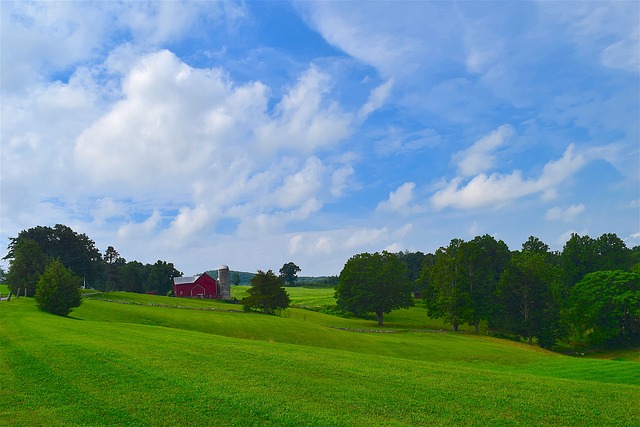June 17, 2021
By Michelle Pelletier Marshall, Global AgInvesting Media
Brad Nordholm’s 40-year career has spanned agricultural and energy finance, capital markets, and credit. Since 2018, he has been president and CEO at Farmer Mac, the nation’s secondary market for agriculture credit. He has shepherded the company through the pandemic and has guided the development of its current strategic plan.
Nordholm leads Farmer Mac with one guiding principle foremost in his mind – the company’s mission: to help increase the availability and affordability of credit for the benefit of American agriculture and rural communities. Farmer Mac is making ever-greater progress in facilitating financial availability to rural America through the purchase and guaranteeing of mortgage loans from agricultural lenders, and in 2020 delivered on a record-setting year in terms of growth, financial results, and expansion into more markets.
GAI News sat down with Nordholm to learn more.
1). As CEO, how do you see Farmer Mac’s current role in the agricultural finance market, and what is your roadmap for its future?
Our past, current, and future role in the ag finance market is to be the preeminent secondary market for credit for American agriculture. Being the largest secondary market provider and working across the United States gives us a diversification of business, but also of the data to support faster, better decisions going forward. We strive to use that data, coupled with 35 years of developed credit and industry expertise, to focus solely on rural American agricultural and rural infrastructure. We want to use that expertise and that diverse portfolio and what we’ve learned from it to always be making better, faster, cheaper decisions for our customers.
That means that we are always working to refine and sharpen the financial products that we offer in the secondary market, and making sure that we’re designing new solutions that are highly responsive to the needs of our customers – originators like commercial banks, the Farm Credit System, and other lending institutions that sell loans they’ve originated to us, who in turn can be responsive to the needs of their borrowers in rural America – the farmers, the ranchers, the agribusinesses, and the rural infrastructure providers of the United States. We don’t anticipate ever moving away from that focus, but we also continuously challenge ourselves to make sure we’re optimizing what we can do for our customer base and for their borrowers. We are always looking for ways to improve how we use technology and data, attract industry-leading talent, and empower our team of highly-skilled and customer-focused professionals to help us deliver on this mission.
2). How has Farmer Mac seen the financial needs change for farm production and agribusinesses? Bigger loans, smaller farms, more leases?
Like all markets, agriculture, including the agricultural credit sector, is constantly changing. Most recently, we’ve seen a growing number of originators from a new class of independent finance companies. The more traditional credit sources, including the Farm Credit System and commercial banks, are also evolving to find ways of being more responsive to their borrowers. That said, some things are staying the same. We are seeing a continuation of many loans going to what are defined by the USDA as smaller farmers; we still have a significant percentage of those loans in our portfolio, and we’re very proud of that. We want to make sure that we are always here for all farmers and ranchers, and especially those with smaller operations.
We’re finding new and innovative ways to help those originators serving smaller farms to make faster, more efficient decisions regarding purchasing loans. Because these usually involve relatively straightforward credits, there are many places where their experience can be streamlined and simplified. For example, originators to smaller farms can take advantage of our recent doubling of the size of our AgXpress credit scorecard product from $750,000 to $1.5 million. This underwriting option touts credit decisions in as little as minutes with minimal documentation requirements, making it faster, easier, and cheaper for the smaller-scaled agricultural producers to take advantage of our low cost of capital.
At the same time, we’re seeing many agricultural operations become much larger and more complex, with multiple entities and owners. We’re also seeing private equity come in and become owners of farmland. With this, we have developed an outreach strategy and the infrastructure to handle larger, more complex loans and more sophisticated transactions.
One way we serving both classes of originators is investing in our talent. Over the last couple of years at Farmer Mac, we have made a major commitment to attract industry-leading talent in roles that are focused on our customers and who understand their needs. We created a new Chief Business Officer position that’s led by Zack Carpenter, who oversees our Agriculture Finance and Rural Infrastructure lines of business, and we have significantly expanded our business development, underwriting, and relationship management resources to give attention to these different market segments.
By all accounts, these areas of emphasis at Farmer Mac have been well-received by the lenders we work with. We’re responding well to the growing and ever-evolving financial needs of the agriculture and rural infrastructure sectors, as recent customer survey results overwhelmingly show. For example, in one recent survey, our net promoter score – a measure of how likely our customers are to recommend us to others – went up by nearly 30 percent year-over-year, and that was during a pandemic. So we know we are heading in the right direction; but we’re not resting on our laurels, we can do even better than that, and that’s something we will continue to do.
3). How many farmers and ranchers do you reach across the U.S.?
We have purchased loans made to nearly 100,000 farmers, ranchers, and farmland owners in all 50 U.S. states. About 25 percent of our agriculture loan purchase portfolio today is in the upper Midwest and about the same amount is in California to producers who produce over 100 different crops. The rest of our portfolio is relatively distributed around the rest of the United States. We’re geographically diverse, and we have accomplished that through a large network of originators. We have been working very hard to increase the portion of those originators that are doing a minimum threshold level business with us. Many of those new customers are giving us high marks for improving their ability to serve farmers and ranchers.
4). How has the pandemic changed the availability and affordability of credit for agriculture and rural communities?
One effect of the pandemic was massive intervention by the Federal Reserve Bank in the credit markets in the United States, and the implications for that were that the overall cost of credit dropped, given the decrease in interest rates. So Farmer Mac has been able to borrow in the U.S. debt capital markets over the last year at record low rates. We pass those savings on to our customers in the form of the rates at which we’ll purchase loans from them. They in turn pass those rates on to their borrowers, whether farmers, ranchers, agribusinesses, rural electric cooperatives, or rural utilities. The end result is that there have been massive amounts of new credit, as well as refinanced credit, going to agricultural and rural America at record low rates. We are thrilled about that because we estimate that for every dollar of interest saved by a farmer or rancher, roughly two dollars are created through spending at local businesses, communities, and governments. And we’re thrilled that we’ve facilitated loans shifting into long-term fixed rate products. We think it’s good that those customers are locking in long-term fixed rates at today’s historic low rates. This is a silver lining to the pandemic: that credit has been low cost. We’ve played a role in making sure more loans are set with a long-term fixed rate.
5). What opportunities does Farmer Mac’s business model present for our Global AgInvesting (GAI) investor audience?
First of all, we think that the Global AgInvesting audience and the conference are terrific. We have been an enthusiastic participant for some time and certainly will be again this year. I’m personally looking forward to attending. Certainly, calling it the Global AgInvesting conference is appropriate, because U.S. agriculture is attracting the attention of investors from across the world, and frankly, from across the capital and investment spectrum, from venture capital, all the way to fixed rate, senior secured credit to equity investors.
When we think about who is participating in the conference, that includes new classes of loan originators who we’re excited to see; people who are originating senior secured credit; people who are originating subordinated or junior credit to farmers, to ranchers, to agribusinesses; people who are investing in farmland and who need credit to leverage their investments; and parties who are investing in agribusinesses, in distribution and processing. Again, those represent people who need credit and Farmer Mac is here for them. We are enthusiastically executing transactions inside the farm gate up through the value chain to owners of agribusinesses. We are here to provide senior secured credit to a wide variety of the participants of Global AgInvesting. And we’re excited that there are so many institutional investors from around the world, including pension funds, endowments and foundations, insurance companies, as well as agribusinesses and farmland and food fund managers and many others who are interested in this sector. We believe that interest in ag investing is driven to a significant degree by the fact that investing in agriculture in the United States represents one of the safest and most promising investments globally.
If you’re a global agriculture investor, the U.S. has the best foundation for investing in the world, which includes consistent tax and tariff laws related to investing. We also have one of the best transportation sectors in the world for moving agricultural product both domestically and internationally, and we have among the best climates in the world for agricultural production. When you put all that together, investors who have a long-term outlook of 25 to 50 years see that production agriculture in the U.S. represents a very interesting long-term opportunity and can be a part of their portfolio. At the same time, the innovation going on in technology-driven investments in agriculture, which includes venture capital, is very exciting. Certainly, global leaders are here in the U.S., and many of the most exciting new investment opportunities are here as well.
6). Your chief economist, Jackson Takach, is speaking at the upcoming Global AgInvesting On the Green conference (in New York in July) on the topic of farmland as an asset class. Without giving too much away, can you tell us how farmland and agribusiness assets have performed during the pandemic and recession? Have they proven more resilient than some other sectors?
Certainly the resilience of American agriculture has been incredible. Production agriculture has performed superbly during the pandemic and that has resulted in favorable levels of production for most agricultural commodities in the U.S., increasing levels of agriculture exports, and very strong rallies in prices for agricultural commodities, which has all provided strong support for farmland values in the United States. But when it comes to resilience, what happened with the agricultural supply chains in the early days of the pandemic – moving food from the farm, through processing, through the distribution channels to the end consumer – we saw some dislocation with some processing and distribution channels. But the adjustments the sector made to those supply chains as a result of that dislocation were truly impressive. I think anyone looking at the sector today has to conclude that American agriculture and our processing and distribution channels are incredibly resilient. And the American consumer is one of the beneficiaries.
7). What do you foresee in the future of lending for American agriculture?
Our goal is to make sure that we’re a reliable, innovative, low-cost secondary market purchaser of loans to American agriculture and rural infrastructure for the benefit of all of rural America. We want to ultimately be a driver for economic development in rural America. What we see for the future are new opportunities for the application of technology and big data-driven information regarding arable land across the United States that can be used to optimize choices for planting, production, harvesting, and more.
And also, using technology to better understand the implications for valuing farmland and making faster, better decisions for mortgage and operating credit for those farmers and ranchers ultimately makes it easier and cheaper for them to borrow. That’s the big trend, the big factor that we see developing in agricultural lending, and it is ultimately going to be very good for farmers and ranchers in rural America. We never want to lose the personal touch, but when we can make better, faster, cheaper decisions by utilizing the technology and big data that’s available, we want to make sure that we do that.
ABOUT BRAD NORDHOLM
Brad Nordholm is president & CEO of Farmer Mac where he leads the company’s efforts to successfully deliver on its core mission of increasing the availability and affordability of credit for the benefit of American agriculture and rural communities. With a career that spans over four decades, Nordholm is a seasoned executive with a wealth of experience in the financial services environment, as well as in agricultural and energy finance, capital markets, and credit.
 Prior to joining Farmer Mac in October 2018, Nordholm was CEO for a decade at Starwood Energy Group Global, LLC, a leading private investment firm specializing in energy infrastructure. Before this, he founded and served as CEO of an energy and power-focused investment firm, Tyr Energy. Nordholm spent the first half of his career in banking focused on agriculture and cooperative organizations.
Prior to joining Farmer Mac in October 2018, Nordholm was CEO for a decade at Starwood Energy Group Global, LLC, a leading private investment firm specializing in energy infrastructure. Before this, he founded and served as CEO of an energy and power-focused investment firm, Tyr Energy. Nordholm spent the first half of his career in banking focused on agriculture and cooperative organizations.
Nordholm has served on various boards of directors, such as for an energy storage company, numerous power generation companies, a solar development firm, and various industry association and business boards. He was born and raised in Cloquet, Minnesota and completed his undergraduate degree in Economics at Carleton College in Northfield, Minnesota.
 Michelle Pelletier Marshall is contributing editor and author for HighQuest Group’s GAI News and Oilseed & Grain News, and managing editor for its WIA Today blog. She can be reached at mmarshall@highquestgroup.com.
Michelle Pelletier Marshall is contributing editor and author for HighQuest Group’s GAI News and Oilseed & Grain News, and managing editor for its WIA Today blog. She can be reached at mmarshall@highquestgroup.com.

Let GAI News inform your engagement in the agriculture sector.
GAI News provides crucial and timely news and insight to help you stay ahead of critical agricultural trends through free delivery of two weekly newsletters, Ag Investing Weekly and AgTech Intel.




